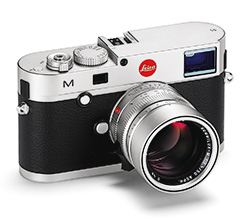Leica M240

 Rangefinder Camera
Rangefinder Camera
Leica's new M240 Rangefinder is the company's second full-frame digital camera, and it packs a lot of new features. The move from a CCD sensor to a new 24-megapixel CMOS sensor and Leica Maestro image processor pays off with rich, detailed, noise-free, high ISO files. The M240 is the first M-series camera to feature Live View and Live View Focusing. The M240 also includes 1080p video. The new CMOS sensor extends compatibility for Leica R legacy lens owners via an adapter.
The camera is well built, crafted from magnesium and brass, and comparatively compact next to a full-frame Nikon or Canon DSLR. Its small size and weight (23.99 oz) makes it easy to carry around all day. The shutter is wonderfully quiet so as not to draw attention and disturb an ongoing situation. I found the shallow thumb grip inadequate for my hand, and the exposure compensation adjustment is awkward and impractical for fast access in the field. It requires you to simultaneously turn a rear dial and press a button on the front of the camera. Otherwise, controls are well placed, except the new dedicated Movie button is prone to being turned on unintentionally. Also impractical is the need to remove the camera's bottom plate to get to the battery and single SD card. Thankfully, the battery has long life.
At its core, the M is a manually focused rangefinder. For those reliant on fast continuous autofocus cameras, this might be a deal-breaker, but I find focusing with the bright optical rangefinder every bit as fast and precise. Looking through the glass of a rangefinder mechanism gives the photographer a much better sense of color and dynamic range compared to an electronic viewfinder (EVF).
Lens framelines in the rangefinder are now lit by an LED—a big help in low light. When in Live View or using the optional EVF-2 Electronic Viewfinder, users can compose the image through the lens for more precise composing, doing away with the rangefinder's associated parallax problems with close-up work. Especially appreciated is the addition of Live View Zoom, which offers 5-10x magnified focus, and Focus Peaking that automatically highlights image contours in red for increased precision. I found the peaking lines difficult to visualize in both the EVF and LCD. The 3″, 920,000-dot LCD is made from Corning Gorilla Glass and holds up well in bright light; however, switching between the LCD and EVF is clumsy, hampered by the need to press a button instead of the EVF being triggered automatically by your eye. Additionally, the EVF is slow, unable to keep up with fast-action subjects.
The ISO range is from 200-3200, with a pull to 100 and a push to 6400. Thanks to the new CMOS sensor, files are noise-free, except at ISO 6400. Large prints from small, cropped areas hold up beautifully. To increase sharpness, there's no low-pass filter, and the good news is that I didn't see one moiré pattern in any of the images I shot, including clothing fabric. In continuous mode, the M captures RAW files at 4 frames per second, up to 12 frames before filling the buffer.
The combination of Leica's incredible lenses, new full-frame sensor, and Maestro processor delivers high-quality files; however, it's expensive and in need of a fix for some ergonomic problems. There are plenty of Leica aficionados that will readily give up some speed and conveniences for the end results.
Company: Leica
Price: $6,950 (body only)
Web: www.leica.com
Rating: 4
Hot: Move to CMOS sensor
Not: No USB or HDMI connectivity
